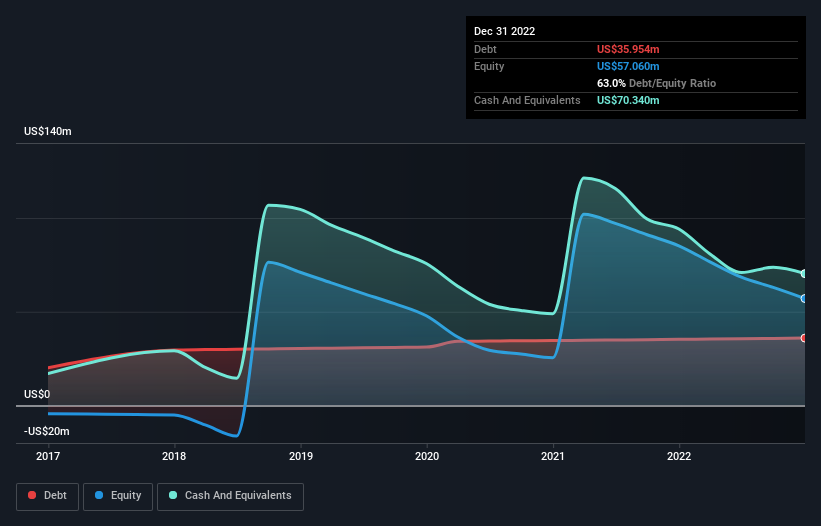- United States
- /
- Medical Equipment
- /
- NasdaqGM:STIM
Does Neuronetics (NASDAQ:STIM) Have A Healthy Balance Sheet?
Legendary fund manager Li Lu (who Charlie Munger backed) once said, 'The biggest investment risk is not the volatility of prices, but whether you will suffer a permanent loss of capital.' So it seems the smart money knows that debt - which is usually involved in bankruptcies - is a very important factor, when you assess how risky a company is. As with many other companies Neuronetics, Inc. (NASDAQ:STIM) makes use of debt. But is this debt a concern to shareholders?
When Is Debt Dangerous?
Debt assists a business until the business has trouble paying it off, either with new capital or with free cash flow. Part and parcel of capitalism is the process of 'creative destruction' where failed businesses are mercilessly liquidated by their bankers. While that is not too common, we often do see indebted companies permanently diluting shareholders because lenders force them to raise capital at a distressed price. Of course, debt can be an important tool in businesses, particularly capital heavy businesses. The first step when considering a company's debt levels is to consider its cash and debt together.
View our latest analysis for Neuronetics
What Is Neuronetics's Debt?
As you can see below, Neuronetics had US$36.0m of debt, at December 2022, which is about the same as the year before. You can click the chart for greater detail. But it also has US$70.3m in cash to offset that, meaning it has US$34.4m net cash.

How Strong Is Neuronetics' Balance Sheet?
The latest balance sheet data shows that Neuronetics had liabilities of US$33.2m due within a year, and liabilities of US$26.6m falling due after that. On the other hand, it had cash of US$70.3m and US$15.4m worth of receivables due within a year. So it actually has US$25.9m more liquid assets than total liabilities.
This surplus liquidity suggests that Neuronetics' balance sheet could take a hit just as well as Homer Simpson's head can take a punch. On this view, lenders should feel as safe as the beloved of a black-belt karate master. Succinctly put, Neuronetics boasts net cash, so it's fair to say it does not have a heavy debt load! When analysing debt levels, the balance sheet is the obvious place to start. But ultimately the future profitability of the business will decide if Neuronetics can strengthen its balance sheet over time. So if you're focused on the future you can check out this free report showing analyst profit forecasts.
Over 12 months, Neuronetics reported revenue of US$65m, which is a gain of 18%, although it did not report any earnings before interest and tax. We usually like to see faster growth from unprofitable companies, but each to their own.
So How Risky Is Neuronetics?
We have no doubt that loss making companies are, in general, riskier than profitable ones. And the fact is that over the last twelve months Neuronetics lost money at the earnings before interest and tax (EBIT) line. And over the same period it saw negative free cash outflow of US$34m and booked a US$37m accounting loss. But at least it has US$34.4m on the balance sheet to spend on growth, near-term. Overall, its balance sheet doesn't seem overly risky, at the moment, but we're always cautious until we see the positive free cash flow. When analysing debt levels, the balance sheet is the obvious place to start. However, not all investment risk resides within the balance sheet - far from it. For instance, we've identified 5 warning signs for Neuronetics that you should be aware of.
When all is said and done, sometimes its easier to focus on companies that don't even need debt. Readers can access a list of growth stocks with zero net debt 100% free, right now.
Valuation is complex, but we're here to simplify it.
Discover if Neuronetics might be undervalued or overvalued with our detailed analysis, featuring fair value estimates, potential risks, dividends, insider trades, and its financial condition.
Access Free AnalysisHave feedback on this article? Concerned about the content? Get in touch with us directly. Alternatively, email editorial-team (at) simplywallst.com.
This article by Simply Wall St is general in nature. We provide commentary based on historical data and analyst forecasts only using an unbiased methodology and our articles are not intended to be financial advice. It does not constitute a recommendation to buy or sell any stock, and does not take account of your objectives, or your financial situation. We aim to bring you long-term focused analysis driven by fundamental data. Note that our analysis may not factor in the latest price-sensitive company announcements or qualitative material. Simply Wall St has no position in any stocks mentioned.
About NasdaqGM:STIM
Neuronetics
Engages in providing in office treatments for patients with neurohealth disorders in the United States and internationally.
Fair value with low risk.
Similar Companies
Market Insights
Community Narratives



